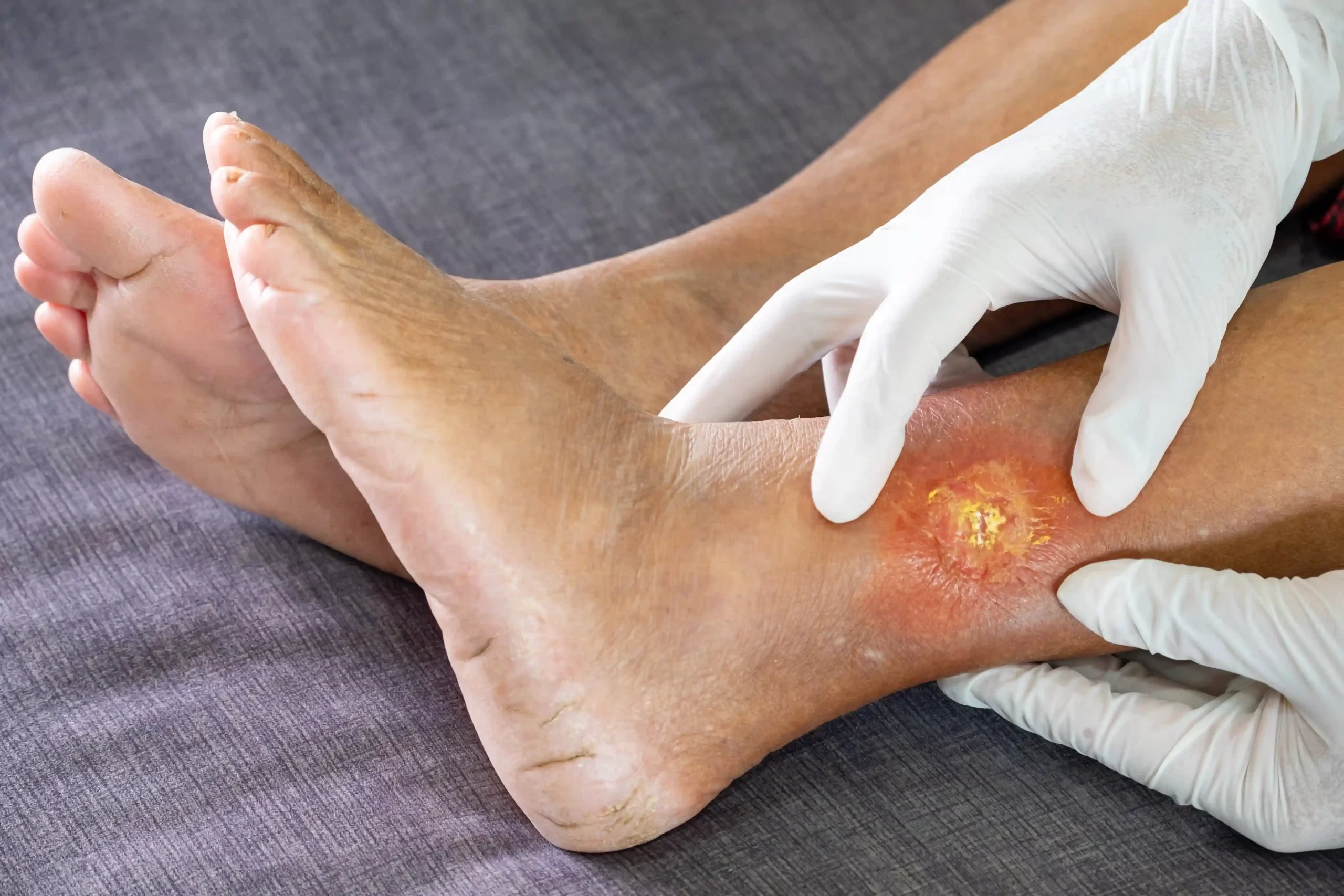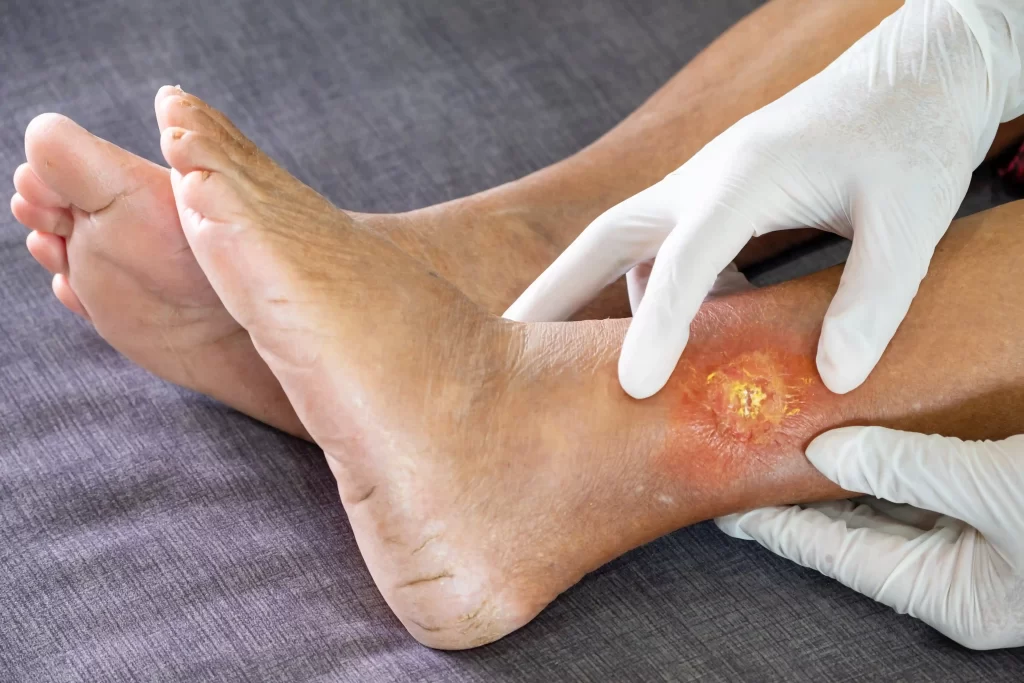
How to Identify the Early Signs of Arterial Leg Ulcers
How to Identify the Early Signs of Arterial Leg Ulcers
Table of Contents
ToggleQuick Summary:
- Persistent Leg Pain – Early arterial ulcers often begin with burning or throbbing pain, especially at night or when resting.
- Small Round Wounds – Ulcers usually appear as small, well-defined sores with “punched-out” edges that heal slowly.
- Cold, Shiny Skin – Skin around the ulcer may feel cold, tight, or glossy due to poor blood flow.
- Skin Color Changes – Pale, bluish, or black discoloration around the wound signals restricted circulation.
- Slow Healing or Non-Healing Sores – Minor cuts or blisters that don’t heal properly are a hallmark of arterial wounds.
Arterial leg ulcers are painful wounds that often develop when blood flow to the legs is restricted. Spotting the early arterial ulcer symptoms is critical because timely diagnosis and treatment can prevent complications like infections, worsening pain, or even surgery. In this blog, we’ll cover what arterial ulcers are, the common warning signs, and why early detection matters. Along the way, we’ll also provide resources to help you learn more about causes, treatments, and specialized care.

What Are Arterial Leg Ulcers?
An arterial ulcer is a type of open wound that develops when poor circulation limits the delivery of oxygen and nutrients to the tissues in your legs. These ulcers are sometimes referred to as arterial wounds, and they typically appear on the feet, heels, toes, or outer ankles. Unlike other types of leg ulcers caused by vein problems, arterial ulcers are directly linked to conditions such as peripheral artery disease (PAD), diabetes, or atherosclerosis.
If you’d like to explore the underlying causes in more detail, you can check out our related blog on what arterial leg ulcers are and their causes.
Early Arterial Ulcer Symptoms You Shouldn’t Ignore
Recognizing the early signs of arterial wounds is the most important step in protecting your health. These ulcers rarely appear overnight; they usually develop slowly, starting with subtle changes in your legs and feet. Let’s break down the key arterial ulcer symptoms to watch for:
1. Persistent or Worsening Leg Pain
Pain is one of the earliest and most common indicators. This discomfort is usually described as a burning or throbbing sensation that intensifies when you’re resting or lying down. Some patients notice relief when sitting upright or dangling their feet over the bed, as gravity helps blood flow more easily to the legs. If pain interferes with your sleep or daily activities, it’s a strong sign that circulation may be compromised.
2. Small, Round Wounds With “Punched-Out” Edges
Unlike cuts or scrapes that heal quickly, early arterial ulcers appear as round, shallow sores. They often have smooth, well-defined edges that make the wound look as though it has been “punched out.” At first, the ulcer may be small, but without proper blood supply, it struggles to heal and may gradually deepen.
3. Pale, Yellow, or Black Wound Base
The base of the wound may appear pale, grayish, or even yellow. As the ulcer worsens, tissue damage may cause parts of the wound to turn black, a sign of tissue death. This discoloration is an urgent warning that the wound is not getting enough oxygen.
4. Cold and Shiny Skin Around the Ulcer
Poor circulation often makes the skin around arterial wounds feel noticeably colder than the surrounding areas. You might also notice that the skin becomes shiny, tight, and thin before the ulcer appears. These changes are your body’s way of signaling reduced blood supply in the area.
5. Skin Color Changes
Pay close attention to any unusual color changes in your lower legs, feet, or toes. The skin may look pale when elevated and then turn reddish or bluish when the legs are lowered. In some cases, the skin near the ulcer becomes darkened or even black if the condition progresses.
6. Slow or Non-Healing Sores
One of the clearest signs of an arterial wound is poor healing. Even minor injuries such as scratches, cuts, or blisters may linger for weeks or months without improvement. This happens because limited circulation prevents the delivery of essential nutrients and oxygen to the wound.
7. Weak or Absent Pulses in the Feet
Doctors often check for pulses in your feet and ankles. If you can barely feel a pulse or none at all, it may mean that the arteries in your legs are blocked. While this may not be easy to detect on your own, noticing cold feet, pain when walking, or recurring sores is often an early indicator.
8. Additional Subtle Signs
Other small changes can also point to the early stages of an arterial ulcer:
- Reduced hair growth on your legs, ankles, and feet.
- Brittle, thick toenails that grow slowly.
- Increased nighttime pain, especially when lying flat.
These signs may seem minor at first, but when they appear together, they suggest circulation issues that could lead to an ulcer if not addressed quickly.
Why Early Detection Matters
Identifying arterial ulcer symptoms as soon as possible can make a significant difference in your recovery. Left untreated, arterial wounds can lead to severe infections, tissue damage, and in extreme cases, amputation. Early diagnosis allows healthcare professionals to improve circulation, manage underlying conditions, and provide advanced wound care treatments to promote healing.
To learn more about treatment options, visit our detailed arterial leg ulcer service page.
Conclusion
Arterial leg ulcers don’t start as large wounds; they begin with subtle signs like persistent pain, small round sores, shiny cold skin, and slow-healing cuts. By paying attention to these early arterial ulcer symptoms, you can seek medical care before the condition worsens.
If you or a loved one is noticing these signs, don’t delay. Reach out to our wound care specialists today through our Contact Us page to schedule an appointment and take the first step toward recovery.
Frequently Asked Questions:
1. What are the first signs of an arterial leg ulcer?
The first signs include persistent leg pain, small round sores, shiny, cold skin, and slow healing of even minor cuts.
2. How do I know if a wound is an arterial ulcer?
Arterial ulcers usually appear on the toes, feet, or outer ankles. They look round with smooth edges and often cause severe pain.
3. Why do arterial ulcers cause pain at night?
When lying down, blood flow to the legs decreases further, making pain worse. Sitting up or dangling legs often relieves discomfort.
4. What does the skin around an arterial ulcer look like?
The skin may appear pale, bluish, or black, and it often feels cold, thin, and shiny compared to healthy skin.
5. Do arterial ulcers heal on their own?
No, arterial ulcers rarely heal without treatment because poor circulation prevents proper wound recovery.
6. Where do arterial ulcers commonly appear?
They typically develop on toes, heels, outer ankles, and sometimes on the tops of feet, where the blood supply is weakest.
7. How are arterial ulcers different from venous ulcers?
Arterial ulcers are very painful, round, and on the outer leg or foot, while venous ulcers are usually on the inner ankle with swelling.
8. Can poor circulation cause ulcers without an injury?
Yes, reduced blood flow can damage skin tissue, leading to ulcers even without an obvious cut or scrape.
9. What happens if an arterial ulcer is left untreated?
Untreated ulcers can lead to severe infections, tissue death, and, in extreme cases, amputation.
10. When should I see a doctor for a suspected arterial ulcer?
If you notice persistent pain, slow-healing sores, or color changes in your legs or feet, seek medical care immediately.


